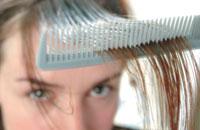Trying to decapitate the crust problem

In the research, an international team of scientists from the University of Ohio (USA) worked. In addition, they have had the collaboration of experts from the multinational Procter Gamble. This multinational produces a wide variety of products for body hygiene, among others, and it is well known anti-dandruff shampoo that it sells. This discovery will represent a great advance in the research of this type of products.
It was known that the fungus Malassezia globosa is the main responsible for the release, which also produces seborrheic dermatitis, psoriasis and eczema. The fungi of the genus Malassezia have much to see in some skin diseases. These fungi do not produce fatty acids, although they are necessary to live. Therefore, they feed on the superficial fat of the human being.
10 liters of fungi
To carry out the research, 10 liters of fungus M. globosa were produced in the laboratory. To get this figure out of the laboratory, we would have to collect the scalp fungi from the entire population of London.
Through this study they have found that the genome of this fungus is formed by 4,285 genes, 300 times less than the human genome. The genome study has shown that this fungus produces eleven kinds of enzymes, namely eight lipases and three phytolipases. These enzymes are the ones that use the fungus to fragment the sebum proper to the skin. It is then inserted into the first layer of the skin, where it breaks the surface cells.

M. globosa is a process that does not pose problems to the person who has a normal amount of fungi. This mechanism allows the monthly renewal of skin cells. However, an excess of fungi accelerates the process. The number of dead cells increases and are released in block. This is an excessive release of the cells of the mental skin.
According to scientists, the genome of M. globosa will contribute to developing pathways of fighting many fungi, both in humans and animals. Among them, it is believed that shampoos or genetic creams can be developed to fight against these fungi.
Body of fungi
Fungi live as parasites in animals and plants. On the human surface there can be millions of fungi that live in balance with bacteria in all parts of our body. In normal conditions, they usually do not cause discomfort, but if they reproduce too much, the balance breaks and problems may arise. External factors such as heat, humidity or poor hygiene can influence this growth. But also the decrease in defenses by antibiotics or other disease, or poor blood circulation or the use of clothes or shoes that make it difficult to correct oxygenation of the skin.

On the scalp can be found about 10 million fungi that can be controlled in some way by shampoos. Although the study of the fungus that causes crust may appear to be small, it is estimated that 50% of the population has crust problems. If you are also one of those, and you have the dark clothes completely discarded from your wardrobe, have hope. In fact, this can be the line of research that will manage to eliminate once and for all the crust problem.
Published in 7k
Buletina
Bidali zure helbide elektronikoa eta jaso asteroko buletina zure sarrera-ontzian











